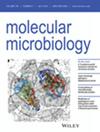Type IV Pili-Associated Secretion of a Biofilm Matrix Protein From Clostridium perfringens That Forms Intermolecular Isopeptide Bonds
IF 2.6
2区 生物学
Q3 BIOCHEMISTRY & MOLECULAR BIOLOGY
引用次数: 0
Abstract
Clostridium perfringens is a gram-positive, anaerobic, spore-forming bacterial pathogen of humans and animals. C. perfringens also produces type IV pili (T4P) and has two complete sets of T4P-associated genes, one of which has been shown to produce surface pili needed for cell adherence. One hypothesis about the second set of T4P genes is that they comprise a type II secretion system (TTSS) like those found in gram-negative bacteria, but for gram-positive bacteria, the TTSS would aid transit across the thick peptidoglycan (PG) layer. The secretome of mutants lacking type IV pilins was examined, and a single protein, BsaC (CPE0517), was identified as being dependent on pilin PilA3 for secretion. The bsaC gene is in an operon with genes encoding a SipW signal peptidase and two putative biofilm matrix proteins, BsaA and BsaB, both of which have remote homology to Bacillus subtilis biofilm protein TasA. Since BsaA forms long oligomers that are secreted, we analyzed BsaA monomer interactions with de novo modeling. These models projected that the monomers formed isopeptide bonds as part of a donor strand exchange process. Mutations in residues predicted to form the isopeptide bonds led to the loss of oligomerization, supporting an exchange and lock mechanism, and isopeptide bonds were detected by mass spectrometry methods. Phylogenetic analysis showed the BsaA family of proteins is widespread among bacteria and archaea, but only a subset is predicted to form isopeptide bonds.

产气荚膜梭菌形成分子间异肽键的生物膜基质蛋白的IV型毛毛相关分泌
产气荚膜梭菌是一种革兰氏阳性、厌氧、孢子形成的细菌病原体,存在于人类和动物中。产气荚膜梭菌也能产生IV型毛(T4P),并具有两套完整的T4P相关基因,其中一套已被证明能产生细胞粘附所需的表面毛。关于第二组T4P基因的一种假设是,它们组成了一个II型分泌系统(TTSS),就像在革兰氏阴性细菌中发现的那样,但对于革兰氏阳性细菌,TTSS将有助于通过厚的肽聚糖(PG)层进行转运。对缺乏IV型匹林的突变体的分泌组进行了检测,发现一个单独的蛋白BsaC (CPE0517)依赖匹林PilA3分泌。bsaC基因位于一个操纵子中,其基因编码SipW信号肽酶和两个假定的生物膜基质蛋白BsaA和BsaB,这两个蛋白都与枯草芽孢杆菌生物膜蛋白TasA具有远程同源性。由于BsaA形成分泌的长低聚物,我们用从头建模分析了BsaA单体相互作用。这些模型预测单体形成的异肽键是供体链交换过程的一部分。预测形成异肽键的残基的突变导致寡聚化的丧失,支持交换和锁定机制,并通过质谱方法检测异肽键。系统发育分析表明,BsaA蛋白家族在细菌和古细菌中广泛存在,但只有一小部分被预测形成异肽键。
本文章由计算机程序翻译,如有差异,请以英文原文为准。
求助全文
约1分钟内获得全文
求助全文
来源期刊

Molecular Microbiology
生物-生化与分子生物学
CiteScore
7.20
自引率
5.60%
发文量
132
审稿时长
1.7 months
期刊介绍:
Molecular Microbiology, the leading primary journal in the microbial sciences, publishes molecular studies of Bacteria, Archaea, eukaryotic microorganisms, and their viruses.
Research papers should lead to a deeper understanding of the molecular principles underlying basic physiological processes or mechanisms. Appropriate topics include gene expression and regulation, pathogenicity and virulence, physiology and metabolism, synthesis of macromolecules (proteins, nucleic acids, lipids, polysaccharides, etc), cell biology and subcellular organization, membrane biogenesis and function, traffic and transport, cell-cell communication and signalling pathways, evolution and gene transfer. Articles focused on host responses (cellular or immunological) to pathogens or on microbial ecology should be directed to our sister journals Cellular Microbiology and Environmental Microbiology, respectively.
 求助内容:
求助内容: 应助结果提醒方式:
应助结果提醒方式:


